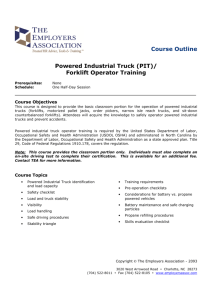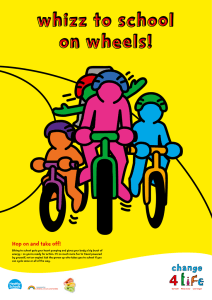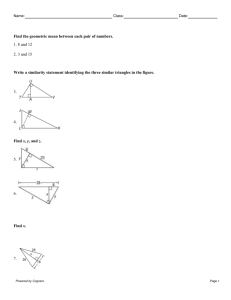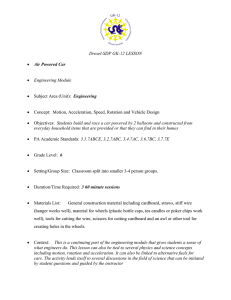Lesson Plan
advertisement
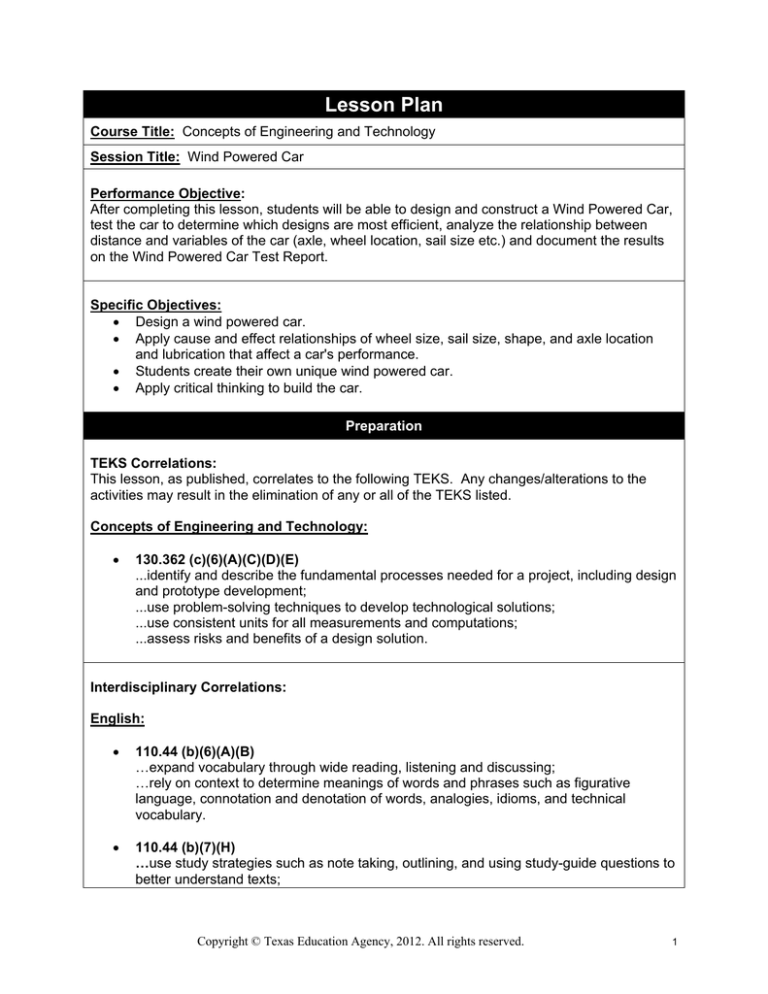
Lesson Plan Course Title: Concepts of Engineering and Technology Session Title: Wind Powered Car Performance Objective: After completing this lesson, students will be able to design and construct a Wind Powered Car, test the car to determine which designs are most efficient, analyze the relationship between distance and variables of the car (axle, wheel location, sail size etc.) and document the results on the Wind Powered Car Test Report. Specific Objectives: Design a wind powered car. Apply cause and effect relationships of wheel size, sail size, shape, and axle location and lubrication that affect a car's performance. Students create their own unique wind powered car. Apply critical thinking to build the car. Preparation TEKS Correlations: This lesson, as published, correlates to the following TEKS. Any changes/alterations to the activities may result in the elimination of any or all of the TEKS listed. Concepts of Engineering and Technology: 130.362 (c)(6)(A)(C)(D)(E) ...identify and describe the fundamental processes needed for a project, including design and prototype development; ...use problem-solving techniques to develop technological solutions; ...use consistent units for all measurements and computations; ...assess risks and benefits of a design solution. Interdisciplinary Correlations: English: 110.44 (b)(6)(A)(B) …expand vocabulary through wide reading, listening and discussing; …rely on context to determine meanings of words and phrases such as figurative language, connotation and denotation of words, analogies, idioms, and technical vocabulary. 110.44 (b)(7)(H) …use study strategies such as note taking, outlining, and using study-guide questions to better understand texts; Copyright © Texas Education Agency, 2012. All rights reserved. 1 Mathematical Models with Applications: 111.36 (c)(M.1)(A)(B)(C) ...compare and analyze various methods for solving a real-life problem; ...select a method to solve a problem, defend the method, and justify the reasonableness of the results. Physics: 112.39 (c)(2)(B)(C)(D)(E) ...know that scientific hypotheses are tentative and testable statements that must be capable of being supported or not supported by observational evidence. Hypotheses of durable explanatory power which have been tested over a wide variety of conditions are incorporated into theories; ...know that scientific theories are based on natural and physical phenomena and are capable of being tested by multiple independent researchers. Unlike hypotheses, scientific theories are well-established and highly-reliable explanations, but may be subject to change as new areas of science and new technologies are developed; ...distinguish between scientific hypotheses and scientific theories; ...design and implement investigative procedures, including making observations, asking well-defined questions, formulating testable hypotheses, identifying variables, selecting appropriate equipment and technology, and evaluating numerical answers for reasonableness; 112.39 (c)(3)(A) ...in all fields of science, analyze, evaluate, and critique scientific explanations by using empirical evidence, logical reasoning, and experimental and observational testing, including examining all sides of scientific evidence of those scientific explanations, so as to encourage critical thinking by the student; Teacher Preparation: Understand how to build a wind powered car and the factors that will ultimately affect the car's distance. This project relates design, drafting, and physics since students will be considering basic physics principles. Instructional Aids: 1. Wind Powered Car PowerPoint presentation 2. Wind Powered Car Test Report for each student Materials Needed: 1. Paper 2. Pencil 3. Milk Carton 4. Tape 5. Axles 6. Wheels Copyright © Texas Education Agency, 2012. All rights reserved. 2 7. Some S type off sail and ma ast (BE CRE EATIVE) Equipme ent Needed: 1. Computer C 2. Overhead O pro ojector 3. Electric E fan n: None required. Learner Preparation Inttroduction Introduc ction (LSI Quadrant I): SAY: To oday we are going to design wind po owered carss. ASK: Do oes anyone know any well w known de esigns? (havve class sha are ideas) SAY: Wind W powered d cars actually exist. In this challeng ge I'm going to have you develop your own wind d powered car and comp pete againstt your classm mates. ASK: Ca an anyone th hink of anyth hing that mig ght be of imp portance to cconsider wh hen designing your car? ? (let class discuss) d SHOW: Wind Powered Car Pow werPoint presentation. SAY: No ow that you know a few key things to o consider, yyou may beg gin designin ng your car. SHOW: Once stude ents have finished their cars, c allow th hem to test tthem. Recorrd which car went the farthe est. SAY: This car (the winning w car) went w the fartthest becausse (and let the class discuss this be efore you answ wer). Teache er's answer should s be similar to this "This car is a well balan nced car tha at has minimal friction f comp pared to the other cars and a has a m uch greater push force tthan drag fo orce". Outline Outline (LSI ( Quadra ant II): Instructors can use the PowerPo oint presenta ation, slides, handouts, a and note pag ges in conjunctiion with the following ou utline. MI Notes s to Instructtor Outline . gin class dis scussion I. Beg A. Talk about a wind powered p carrs. B. What makes a wind powered car unique.. C. What should you consider wh hen designin ng your car? c er instigates Teache class d discussion ovver wind po owered carss and wh hat factors should be considerred when d designing a wind po owered car. hallenge 1 II. Ch A. Begin n PowerPoint presentatio on. ntation. B. Walk students thrrough presen C. Have students be egin designin ng their wind d powered cars. Teache er presents Wind P Powered Carr PowerP Point for lessson. Cop pyright © Texaas Education Agency, A 2012. A All rights reserrved. 3 hallenge 1 Test II. Ch A. Have students complete theirr cars. B. Begin testing stud dent's cars. C. Recorrd which one es traveled tthe farthest D. Why did d the winniing car win? ? Teache er will supervvise testing to make surre there’s no foul playy. Take note of distancces traveled by each ca ar. Distribu ute the Wind d Powere ed Car Test Report for each studentt. C Discussion IV. Class A. Have winning car individual/te eam give a presen ntation on why w they won n. B. What factors conttributed to itss performance? C. Exam mine other ca ars and comp pare the differe ences. D. Why were w these cars c slow? E. Why did d these carrs travel the farthest? F. Have students wriite up a repo ort on why their car c performed the way it did. G. Then have h the stu udents write a paragraph h about what they would w do diffe erently if the ey were given g anothe er chance. H. Then have h students write a hyypothesis about what part off the car is th he biggest factor in how far itt traveled. (i..e., balance,, sail siz ze, wheel loc cation, bearrings, etc.) - no wrong g answer as long as stud dents have legitim mate reason to assume . er leads a cla ass Teache discusssion. Have studentts write dow wn why ca ars won/lost, what fa actors are most importa ant, and wha at studentts would do differen ntly if given tthe same cchallenge ag gain. onclusion V. Co A. Have students s turn n in papers. B. If there e is leftover time, t have sstudents beg gin Challen nge 3 (New Power P Sourcce). Teache er states the ere is no w wrong answe er as long ass students ha ave data an nd evidence to supporrt their assump ptions and reasoning. Cop pyright © Texaas Education Agency, A 2012. A All rights reserrved. 4 Verbal c Linguistic Logical Mathematic cal Visual Spatial Musical Rhythmic Bodily Kinesthetic Intrapersonal Inte erperrsonal Natura alist Existentiialist Application A Guided Practice P (LS SI Quadrantt III): After clas ss races and d discussion, the teache er will explain n why winnin ng cars won. ce (LSI Qua adrant III): Independent Practic udents evaluate everyone's cars and d explain wh at they woulld change on n their own ffor Have stu next time e. Summary Review (LSI ( Quadra ants I and IV V): Question n: Why did your y car perrform the wa ay it did? Answer: Answers will vary. One e possible an nswer: Our ccar was too h heavy and b because of th hat, our sail could c not gen nerate enough force from m the fan to push the ca ar forward. Question n: Why did the t winning car c win? Answer: Again, answ wers will varry. Should be e similar to g good balancce, good saill to mass proportio on, etc. Question n: What wou uld you do differently if you y made an nother car? Answer: Could be any of the following or oth hers: lighter weight, new w wheel loca ation, bigger sail, evenly diistributed we eight on each wheel, sm maller car, etcc. Evaluation E Informall Assessme ent (LSI Qua adrant III): The teac cher will obse erve the stud dents as the ey construct their cars. L Look for posssible teamwo ork and unique designs. Formal Assessmen A nt (LSI Quad drant III, IV):: The students will cre eate a Wind Powered P Ca ar that should d move whe en placed in front of an electric fa an. The prim mary objectiv ve is to make e the car travvel as far ass possible. S Students will complete e the Wind Powered P Carr Test Reporrt. Cop pyright © Texaas Education Agency, A 2012. A All rights reserrved. 5 Extension Extension/Enrichment (LSI Quadrant IV): If students master the wind power concept, have them experiment with other power sources besides wind (i.e. solar power). Copyright © Texas Education Agency, 2012. All rights reserved. 6 Name: __________________________ Wind Powered Car Test Report Challenge 1: Construct a Wind Powered Car using recycled or commercially sold materials that cannot exceed 24” x 24” x 24” and use a powerful electric fan to push the car. Test and document the results of how far each car was pushed by the wind. 1. How far was your car pushed by the wind? TEST RESULTS Whose wind powered car was tested? Person’s name: Car 1.________ 1. _____________________________ Car 2. _______ 2. _____________________________ Car 3. _______ 3. _____________________________ Car 4. _______ 4. _____________________________ Car 5. _______ 5. _____________________________ (Numbers above correspond with the numbers in Test results column) 2. What factors contributed to each car’s performance? Car 1: Car 2: Car 3: Car 4: Car 5: 3. Why were cars slow? 4. Why did cars travel the farthest? Copyright © Texas Education Agency, 2012. All rights reserved. 7 Evaluation: In the space provided below, write a report on why your car performed the way it did. Include a paragraph about what you would do differently if given another chance. Write a hypothesis about what part of the car is the biggest factor in how far it travels. (balance, sail size, wheel location, bearings, etc.) There are no wrong answers as long as you have legitimate reasons to support your assumptions. ______________________________________________________________________ ______________________________________________________________________ ______________________________________________________________________ ______________________________________________________________________ ______________________________________________________________________ ______________________________________________________________________ ______________________________________________________________________ ______________________________________________________________________ ______________________________________________________________________ ______________________________________________________________________ ______________________________________________________________________ ______________________________________________________________________ ______________________________________________________________________ ______________________________________________________________________ ______________________________________________________________________ ______________________________________________________________________ ______________________________________________________________________ ______________________________________________________________________ ______________________________________________________________________ ______________________________________________________________________ ______________________________________________________________________ ______________________________________________________________________ ______________________________________________________________________ ______________________________________________________________________ ______________________________________________________________________ ______________________________________________________________________ ______________________________________________________________________ ______________________________________________________________________ ______________________________________________________________________ ______________________________________________________________________ ______________________________________________________________________ ______________________________________________________________________ ______________________________________________________________________ ______________________________________________________________________ ______________________________________________________________________ ______________________________________________________________________ ______________________________________________________________________ Copyright © Texas Education Agency, 2012. All rights reserved. 8
